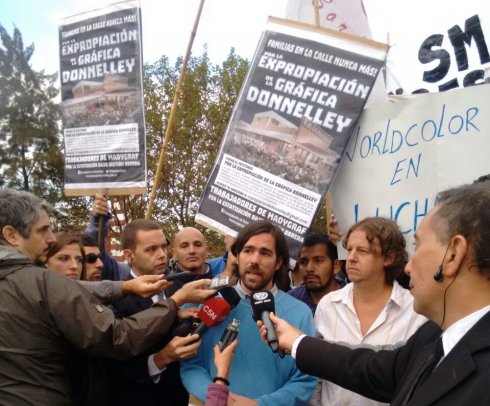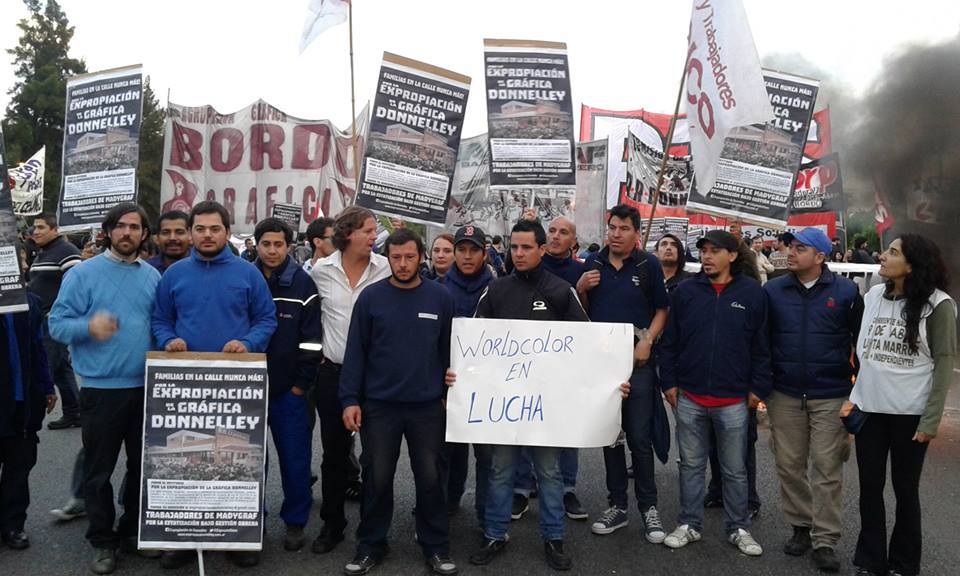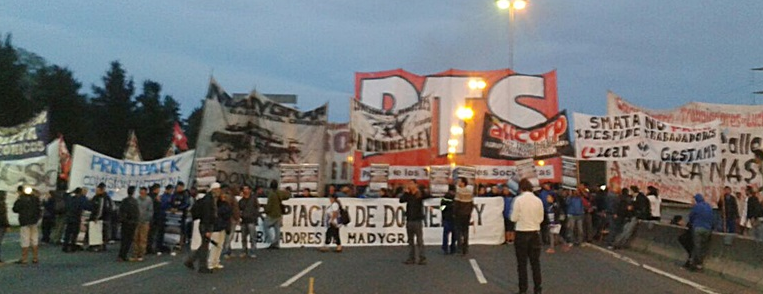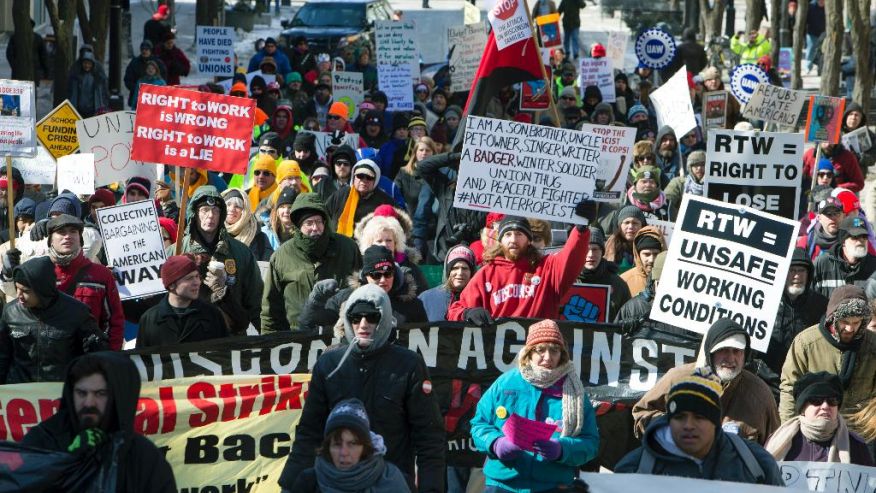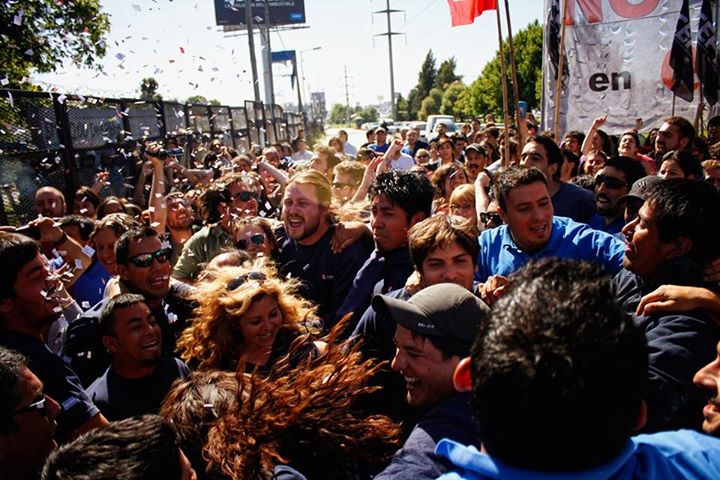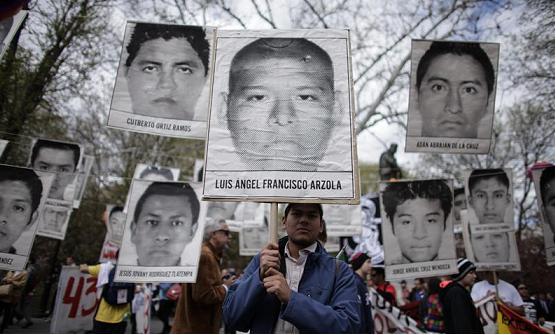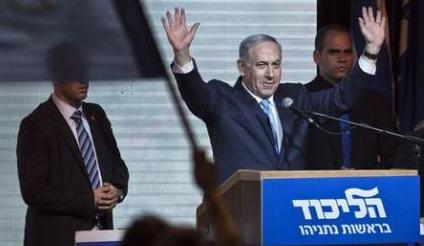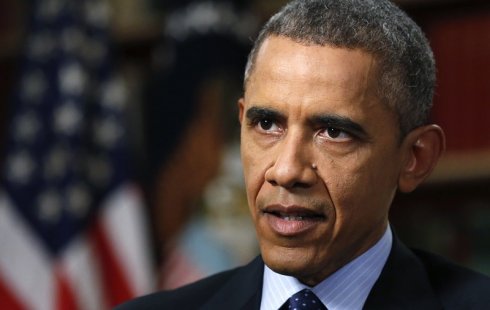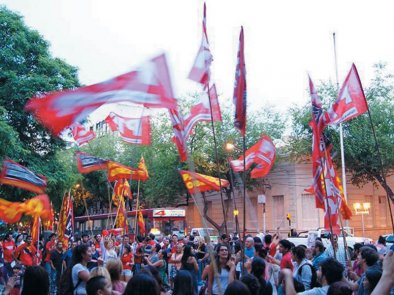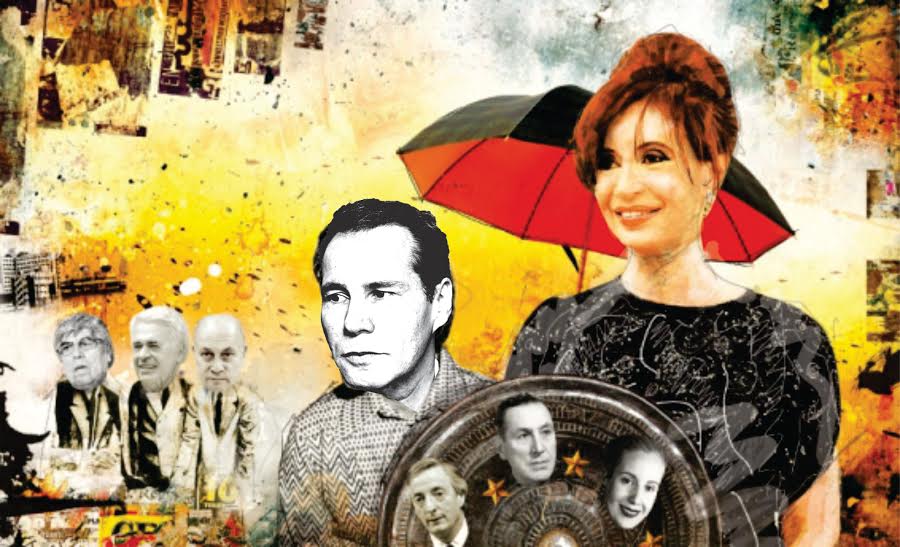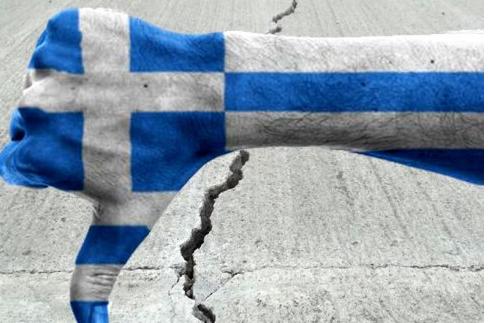Argentina
Before and After the March Crisis
08/06/2009
In Argentina a new government has emerged which is in essence different from the one that took power in December 1999 when the Alianza won after the ’Menem decade’. The recent appointment of Cavallo - who was a minister in Menem’s government and a functionary during the dictatorship - to President De la Rúa’s cabinet and the ’special powers’ given to him by parliament in order to steer economic policy for a year, makes him the centre around whom the executive power of the bourgeoisie gravitates. Until this appointment the presidency of De la Rúa was undergoing a deep crisis as a result of three general strikes during last year and constant changes to and resignations from the cabinet - including nothing less than the resignation of the vice-president. This took place after 35 months of economic standstill and with the spectre of a default in the public debt repayments that is equal to 50% of the GNP. All these elements of the national crisis - political, economic and class struggle - came together in the third week of March, opening a crisis of power that the ruling classes closed with the appointment of Cavallo. It was the latest - but not the final - episode of a series of convulsive events that have been taking place in the country during the latest fifteen months.
In the first place, a sudden change in the government that is not the result of a pre-planned election is, in its way, a confirmation that Argentina is going through a phase of exceptional conditions - or pre-revolutionary conditions as Marxists call it - in which events are not foreseen and development is not evolutionary, even for the ruling class. The delegation of legislative power to a ’strong man’ in the executive is a qualitative leap for the bourgeoisie, and is related to the ’exceptional situations’ which are provided for in the constitutions of most republics. As Lenin said, even the most democratic of republics has "a clause to assure domination over its slaves when they threaten to overthrow that yoke". How did we reach the March crisis?
The rulers cannot rule
The weakness of the De la Rúa government has its origin in the formation of the Alianza itself, an alliance which consists of the UCR (the Radical Party) and FREPASO (Frente País Solidario). This electoral alliance emerged in 1997 and was used by the regime as a mechanism to derail the counter-offensive of the masses against Menem and Cavallo that started in 1996. Despite being successful in achieving a peaceful removal of the hated Menem government, the alliance’s strategic weakness is that it is only a sticking plaster on the two-party system of the UCR and the Peronists of the PJ (Partido Justicialista), which was reborn in 1983 after the fall of the dictatorship, and is in terminal crisis.
Once in office, where the monopolies rule, the Alianza came into conflict with its social base. The decadent entourage of relatives, spin doctors and secret service agents that surrounds President De la Rúa, thought that the government could maintain its initial popularity in spite of the implementation of unpopular measures such as the labour reform and the reduction of the salaries of public sector workers - but it was completely wrong. The response was three general strikes in 2000 that undermined the government while developing the strength of the working class. Forcing the labour reform bill through the Senate by means of bribery provoked the resignation of the vice-president and Frepaso leader, Chacho Alvarez, resulting in a loss of legitimacy for the political regime in the eyes of the masses. Frepaso is the main component of the Alianza and without its presence it would been have impossible for the old and discredited UCR to win the presidency. When Frepaso broke apart, its broad social base of the middle class, students and state workers who had supported the government, started to oppose De la Rúa.
These recurrent crises in the political regime reflect not only the erosion of the institutions of Argentine bourgeois democracy and their increasing inability to hold back the mass movement, but ultimately a profound division in the bourgeoisie after a decade of unusual unity between the foreign investors that bought the public enterprises and an elite group of domestic capitalists. This pact - ’the establishment’ - started to split up when the recession came, at the end of the Menem’s government. A new grouping called the ’productive group’ emerged, which includes big monopolies such as Techint (the steel industry), the building industry, sections of the agrarian bourgeoisie, and even the Argentine Industrial Union which by and large represents the ’non-monopolistic bourgeoisie’. These sectors started to challenge the Alianza government, asking for subsidies, preferential tariffs, the reduction of interest rates for credit, and (by the more extreme sectors) the devaluation of the peso - i.e., the end of ’convertibility’, the parity between the dollar and the peso which was established by law in 1991. These claims were to the detriment of the banks - the majority of them foreign - and of the big US and European multinationals which own the privatised companies. A profound difference between the current phase of the class struggle in Argentina and the one which occurred in 96 and 97 under Menem’s government is the notorious rift in the ruling class.
But the explosive ingredient of the current Argentine situation is that in addition to these contradictions in the ranks of the bourgeoisie we see the emergence of the working class, which is now flexing its muscles. Therefore the national political situation has come into line with Lenin’s classic characterisation of exceptional periods as ones in which "the rulers cannot rule as before and those below do not want to continue living as before".
2000: The year the workers erupted onto the scene
The emergence of the working class was at the centre of the events during the year 2000. As a whole, this steady activity of the working masses combined two things: a renewed struggle of the unions as the core of the opposition to the government through general strikes and sectoral strikes, and the tendency to overcome the limits of bourgeois legality among layers of the workers’ movement, especially the unemployed, with confrontations and semi-insurrectional actions such as those in Tartagal and Mosconi in the Salta province on the border with Bolivia. These activities were at a higher level than those in 1996 and 1997. We shall not dwell on the wide range of workers actions, but we want to point out some central characteristics of the maturity of the working class.1 In the first place, its persistence. During 20002 three blows were struck by the working class before the March 2001 crisis in which the Minister of Finance, López Murphy, had to resign. Each action was followed by a truce given to the government by the trade union confederations, highlighting the persistence of the workers.
The first blow against the government started in March and April with demonstrations outside parliament during the vote on the labour reform bill and continued until the first national strike against that anti-working class legislation on May 5. During this period of three months the map of the workers’ movement changed. On the one hand, the Workers Confederation split, with the emergence of a rebel or dissident wing based mainly in the transport unions and in the car factories, which have among the highest concentrations of industrial workers in Argentina. This realignment in the trade union organisations will have enormous importance in future national strikes since the paralysing of transport will became one of the key weapons of the new working class, ensuring mass support for the measures. Secondly, in May the uprising of the unemployed in the cities of Tartagal and Mosconi took place. Those events announced a phenomenon that would develop into the blockade of roads and the militant movement of the unemployed known as ’los piqueteros’.
The second blow included partial strikes by public sector workers whose salaries were reduced by 10%, leading to the second general strike - which had massive support - on June 9. In addition, also in this period, a series of strikes in industry and by regional trade unions took place in spite of a second trade union truce, representing a quantum leap in the struggle in the transport, sugar, fish and ceramics industries, using more radical methods, and with the emergence of new leaders and the tendency to overcome the union bureaucracy. A new truce of the union confederations left the working class with no answer in the face of a new governmental crisis which was provoked by the bribes scandal in the Senate - the truce was a terrible capitulation because the Senate had precisely passed the labour reform bill, which concerned the workers directly. This scandal, in turn, led to the resignation of the vicepresident, Carlos Alvarez.
Nevertheless, a third blow came when the unemployed movement rose up, leading to the third and most important general strike, of 36 hours, on November 23 and 24. Since the beginning of November in La Matanza - a working class district with two million inhabitants on the outskirts of Buenos Aires - thousands of unemployed have blockaded roads and demanded government work schemes. This movement was followed by blockades in the so-called ’south belt’ industrial areas of Florencio Varela, Quilmes and Berazategui. The blockades were getting closer to Buenos Aires city. At the same time, in Tartagal, the second uprising of the unemployed together with sacked transport workers presented a unified list of demands, and took over the main route through Salta province. One of the demonstrators, Anibal Verón, died after being shot by the police. In a small community in the north-east of the country, this event provoked one of the most radical mobilisations of the masses since the advent of bourgeois democracy: the gendarmerie and the police were obliged to withdraw, police stations were occupied, police officers were taken hostage and their arms confiscated. A new working class martyr became the symbol of the third general strike, a strike that the three union confederations, including the CTA, could not prevent.
This general strike, because it was accompanied by the spread of pickets, represented a change from the practices over the last decades of the class struggle in Argentina. It was such a change that even the bourgeoisie, for the first time in many years, was worried. One newspaper said that "the street demonstrations didn’t have the flavour of the trade union confederation but the flavour of the seventies" 3, and there were claims that there were between 150 and 200 thousand people on the pickets. The pickets transformed the call of the trade unions into a truly active strike, with 6.5 million workers from different industries observing the strike. In our edition of La Verdad Obrera at that time, we said: "It was not just another strike … the strike pickets and the blockades of routes spread all over the country, there were blockades of the railways, the main cities were cut off … it is a small sign of what can be achieved by a combination of the traditional methods of struggle of the old unions together with the new uprisings of the unemployed: in short, the strike and the control of the territory by the working class and the popular sectors … This strike helps to outline the road map of the general strike and the uprising on a national basis that we need in order to defeat the government of De la Rua and the IMF plan supported by the Partido Justicialista …"4 After seeing these signs of maturity in the Argentinian working class it is difficult to believe that when the government was preparing to launch a new ’austerity plan’ in March, having had warnings from a member of its own cabinet of the effects that such measures could cause, the hard core around De la Rua encouraged Lopez Murphy (the new Minister of Economy) to press ahead with the plan, saying that "there will be only isolated signs of resistance in some provinces that will be dispersed". 5
The March Crisis
The Alianza administration reached the depths of its crisis when it squandered in a very short period of time the important political support offered by imperialism under the so-called ’blindaje’- a $40 billion bail out promised by the IMF at the end of December 2000. Following the southern hemisphere summer, the country was again on the verge of default, provoking the resignation of the then Minister of Economy, Eduardo Machinea. As a replacement, the finance sector and the De la Rúa clique nominated Ricardo López Murphy, who according to them had the double advantage of being an economist of the orthodox think-tank FIEL loyal to the bankers and also a member of the governing UCR. Using the threat of default as a blackmail against the masses, Murphy tried to impose a plan of cuts to public spending, which would cut $2.2 billion off the state budget by attacking mainly education, the public sector through a harsh reform of the sector, and the regional economies. A ’war plan’ as we called it, but a war plan devised by a inept general who opened up several fronts at the same time. This proposal drew criticism from a broad sector of society - ranging from the UIA (the Argentinean Chamber of Industry) to the working class and the majority of the middle class, including the students’ movement. An image that sums up the situation back then is that of 300 of the top representatives of the bourgeois establishment cheering and applauding Murphy for about fifteen minutes at a reception held in the Chamber of Commerce while the country was living in a state of general insubordination.
Thousands of students occupied the main universities and colleges. It is important to note that the student movement is led by Franja Morada, the student branch of the governing Radical Party, which was obliged to lead actions and confront the government - in fact, the dynamic was one of a break with the government. The public sector workers, that had suffered a defeat a few months earlier with a reduction of their salaries, displayed a militant mood and a willingness to strike. Teachers went on a 48-hour national strike. On March 20, the unemployed movements marched from different points on the outskirts of Buenos Aires to the centre of the Federal Capital, and the next day there was a general strike, the fourth since De la Rúa assumed office and one that the union confederations called in a haste.
By then the crisis had already brought down López Murphy, not just because of the social upheavals but also because of the deepening contradictions in the ruling class itself. The López Murphy economic plan led to the resignation of the UCR Home Office Minister, Federico Storani, and of two members of Frepaso who occupied posts in the national cabinet. The Peronist provincial governors, who had helped De la Rúa obtain the ’blindaje’ (bailout) from the IMF by accepting a "fiscal discipline pact" at the end of last year, spoke out against the Murphy plan, the aim of which was to cut even more the already small budget for the provinces. While De la Rúa was calling for a government of national unity, some of the industrial bosses grouped in the UIA declared themselves ’against the model’. Alfonsín, the leader of the Radicals, was out of the country and keeping his distance from the UCR, while the UCR was manoeuvring so that De la Rúa would not become isolated. The decision to appoint former Menem’s Minister of Economy Cavallo was taken overnight, only few hours after De la Rúa had ratified Murphy as Minister of Economy at the annual general meeting of the BID (Interamerican Bank of Development) in Chile in front of hundreds of bankers and representatives of Latin American governments. That very same day, stock exchanges across the world talked about ’the Argentinean effect’ and the risk of Argentina defaulting on its external debt.
Argentina was going through a crisis in the upper echelons of power - the government was in disarray and when the strike was called on March 21 there were rumours that the president was about to resign. A few days later, a very well-known Argentinean political journalist asked ex-president Menem: "Dou you think that the situation is more calm now?" Menem answered: "Yes, everything is quieter. The strikes, the occupation of the university buildings had made things very difficult." In short, what precipitated López Murphy’s resignation and the defeat of his plan, and the appointment of Cavallo as a key figure in the new government was the crisis of bourgeois power, an objectively revolutionary crisis.
During the latest decades we witnessed only two crises of the same magnitude. The first was in 1982, when, after the military dictatorship capitulated to England in the Malvinas War, the Military Junta was brought down by massive demonstrations, and the power was handed over to the transitional government of General Bignone and the Multipartidaria, a process that led to the 1983 general election. The second was in 1989 under the Radical government of Raúl Alfonsín - who had won the 1983 election. Alfonsín was rendered powerless by a social upheaval brought about by a galloping hyperinflation, which included the looting of supermarkets. After declaring a ’state of siege’ and ordering the repression of the demonstrators, was obliged to bring forward the handing over of office to Menem.
Nevertheless, in neither of these two crises was the working class at the centre of the stage, as it is now, with a general strike like the one on March 21 which put an end to the López Murphy plan. For this reason, some political commentators even compare the crisis with the one before the military coup in 1976: the days of June and July 1975 which led to the general strike that defeated the Minister of Economy under the Isabel Perón government, Celestino Rodríguez, and the rise in prices known as the ’Rodrigazo’. Without reaching the same level of radicalisation as in 1975 - when the working class struggle reached a high point with the creation of dual power co-ordination bodies in Buenos Aires - the fact that in the current situation commentators allowed themselves to make such a comparison speaks clearly of a recovery of the working class after the defeat that the genocidal dictatorship represented.6 Furthermore, if we compare the process in Argentina with the rest of Latin America - where there is an uprising of the peasantry - it is more urban and proletarian.7 After the March crisis, broad layers of the working class, students and the exploited sectors who fought back believed the defeat of the López Murphy plan was a triumph. And to a certain extent it was, although due to the lack of a workers’ and popular organisation to counter bourgeois power, and because the struggle had a bureaucratic and reformist leadership -i.e., the crisis of revolutionary leadership-, the workers could not impose ’their solution’ to the crisis of bourgeois rule and therefore the result of the crisis was a reactionary one.
The official leaderships of the workers and students: the bureaucracy of the Moyano-led "dissident" CGT (Confederation of Trade Unions), the CTA controlled by Victor de Genaro, and the FUA (National Students’ Union) controlled by the UCR, defused the situation. Their programme was limited to demanding the withdrawal of Murphy’s adjustment plan, the effect of which was to facilitate his replacement by Cavallo with the promise of a ’different’ plan. Those who supported Murphy’s cutbacks - the financial sectors - were obliged to retreat because the crisis could have ended up with the fall of De la Rúa - as had happened to Bucaram in Ecuador. De la Rúa could have fallen victim to the general strike and a pre-insurrectional mood of broad sections of the population in the middle of a deep crisis and open division among the rulers.
Cavallo-De la Rúa: A pre-bonapartist government
The ’emergency’ character of the new government that was born out of the March crisis, which has dispensed with parliament for a year, is something new in the 17 years of the ruling regime in Argentina, where bourgeois democracy has prevailed, even during Menem’s government that resorted to the mechanism of ’decree of necessity and urgency’ over and over again. What does a government of this type represent? One of Trotsky’s definitions points out that: "As soon as the struggle of two social strata - the haves and the have-nots, the exploiters and the exploited - reaches its highest tension, the conditions are established for the domination of the bureaucracy, police, soldiery. The government became ’independent’ of society. Let us once more recall: if two forks are stuck symmetrically into a cork, the latter can stand even on the head of a pin. That is precisely the schema of Bonapartism".8 Within this general scheme, semi-colonial governments are a special type of Bonapartism - ’sui generis’ was the term used by Trotsky - because the national bourgeoisie is relatively weak in relation with the two main forces that tend to polarise the situation in the semi-colonies: foreign imperialist capital and the proletariat. These are the ’two forks in the cork’, and between them the Cavallo-De la Rúa government has to balance. This is not because the government is independent of foreign capital - on the contrary - but because it is obliged to maintain a highly unstable balance between these two forces. In order to carry out this function, it has to act as an arbiter between the factions of the bourgeoisie itself, making concessions to the ’non-monopolistic’ bourgeoisie who demand measures ’to revive’ the national economy while at the same time attempting to win the support of wider sections of the middle class. But the fundamental forces that polarise the situation are imperialism and the proletariat, which is expressed by the fact that Cavallo’s programme is aimed at ’satisfying the markets’ as well as ’reviving the economy’, ’creating new jobs’ and ’finding a solution to poverty’.
Some left currents in Argentina, like the Maoist PCR (Partido Comunista Revolucionario), defined the appointment of Cavallo as a ’Fujimorist-like coup’. Although it is clear that the situation contains certain features of this kind, this government is completely different in its genesis. Despite having a formal similarity with the coup of Fujimori in Peru in 1992, where he assumed the powers of the bourgeois parliament, the latter was a result of the exhaustion of the working class, a shift to the right by the middle class against the guerrillas of Sendero Luminoso (Shining Path), a repression which claimed thousand of victims and prisoners, and the international conditions of a neo-liberal offensive which was at its height, disciplining the national bourgeoisies to the ’Washington Consensus’. It was - like the Menem government, although with different forms - the product of a defeat of the masses and of an exceptional bourgeoisie unity which lasted almost a decade. With Trotsky, we claim that "The Bonapartist regime can attain a comparatively stable and durable character only in the event that it brings a revolutionary epoch to a close; when the relationship of forces has already been tested in battles; when the revolutionary classes are already exhausted, but the possessing classes have not yet freed themselves from the fear: will not tomorrow bring new convulsions? Without this basic condition, that is, without a preceding exhaustion of the mass energies in battles, the Bonapartist regime is in no position to develop." 9
Fujimori rested on the armed forces, which provided the regime with another strong man, Montesinos, and he also closed down the parliament during the first period. In Argentina, by contrast, where the armed forces have failed to overcome their historic crisis which started with the fall of the dictatorship due to the masses’ rejection of the genocide and the military defeat by English imperialism in the Malvinas, any candidate for the role of Bonaparte must look for a certain legitimacy in the forms of bourgeois democracy. And this is so to the extent that, since the beginning of last year, Cavallo has been preparing himself for a crisis using the weapons of parliamentary democracy, standing for elections as mayor in the Federal Capital in May 2000 - when he obtained a high percentage of votes among well-off sections of the middle class. This fact announced the emergence of a ’hard right’ prepared to help the regime. Even today, Cavallo’s special powers are limited, for the time being, to economic policy, a limitation imposed by the congress. And these special powers were not the result of a putsch supported by the armed forces, but they rather came out of the guts of the post-Pacto de Olivos regime and its reformed 1994 Constitution. This codified article 76 dictating the delegation of ample powers to the executive, now in force. In other words, the Bonapartist-type government that emerged still relies on the old crisis-ridden institutions of bourgeois democracy and is not a partial negation of the latter as happens with regjmes born out of military dictatorship, but a consequence of the deterioration of the regime that has existed in Argentina for the last 17 years.
This distinction helps us to point out different balances of forces between the classes. With the same methodological criteria, in Germany in the 30s, Trotsky was concerned to distinguish carefully among the series of Bonapartist governments that preceded Hitler, noting the different features of each one of them in contrast to the anti-Marxist simplification of the Stalinists who said that all were ’fascist coup d’etats’. Trotsky says that, "Thanks to the Social Democracy, the Brüning government had at its disposal the support of parliament for ruling with the aid of emergency decrees", which was not the case for the government of Papen that took power following the coup d’ etat on July 20, 1932. Although the Brüning government bore a ’clerical-bureaucratic-police character’, Trotsky pointed out that ’The Reichwehr still remained in reserve’, but that with the Papen coup, ’The generals came to the fore.’ He characterised the Papen government as ’Bonapartist’ and the Brüning government as ’pre-Bonapartist’. Leaving aside the differences in that situation, where the forces of the revolution and the counter-revolution clashed violently - which is not the case at all in Argentine - we use the same methodological criteria to define the government of Cavallo-De la Rúa as pre-Bonapartist, unstable, unsettled.
Open Ended
As a result of the crisis in March we are at a conjuncture that seems to be the opposite of the previous one. The extreme weakness of the government was dealt with by the incorporation of Cavallo into the cabinet and the delegation of special powers to him by parliament. But not only that: if Cavallo attempts in the immediate future a Murphy-like plan, he will last even less time in office than Murphy. The regime has been given breathing space by a treacherous political combination - while the Executive with Cavallo assumes more powers to further its attacks, it sedates the masses with a demagogic discourse and some half-hearted measures to revive the economy.10 This plan is different from the rigid austerity plan supported until recently by the bankers and the IMF. The divisions in the bourgeoisie that have been openly expressed were warded off by the regime by nominating a ’strong man’, an arbiter standing above them. The ruling class has found a driver, at least for the time being. Bourgeois politicians from different factions, that were previously confronting each other, now speak of ’national unity’.
Expectations increased not only in the upper middle class - who already sympathise with Cavallo - but in sections of the lower middle class and even in the working class, that only weeks before had actively rejected Murphy’s plan. The official leadership of the working class played an important role in achieving that. The leader of the dissident CGT, Hugo Moyano, called off a 36-hour strike scheduled to take place during the April FTAA Summit (Free Trade Agreement of the Americas) in Buenos Aires, committing the union to a truce and calling for his members to have ’a bit of hope’ in Cavallo.
In any case, no matter what they say, the bourgeoisie hasn’t found a clear way out of the profound economic recession. The Argentinean newspaper Ambito Financiero points out: "Faced with this gloomy outlook there are ’Cavallo’s measures’ [no one now speaks of the Economy Minister’s ’plan’ because it is accepted that there is no such plan, but a set of well thought-out provisions designed to overcome the financial emergency that the country was going through]. The ’measures’ aim to move the country away from the financial abyss, but leave it slumbering only three metres away from the edge. Moreover, to plug the gaps in the state by sacrificing the private sector can never revive the economy."
The current situation cannot be otherwise than transitory and unclear because Cavallo’s appointment is only preparatory to further attacks on the conquests of the working class and popular sectors. To improve profitability by 20%, as has been promised to the bosses, will only be possible by taking a new slice of surplus value from the workers: either in a direct way as a result of a series of defeats with further wage cuts - i.e., through new worsened labour conditions, holding down the unemployed movement, etc - or indirectly through a devaluation. These are the only two ’strategic’ solutions that the bourgeoisie can offer when faced with the exhaustion of the convertibility system. In the immediate term, they are banking on having a relatively stable political situation until the local elections in October, in order to obtain legitimisation through the vote. After recovering their strength they will implement harsher plans against the masses. But this plan could fail due to the critical international economic situation - a situation that has been expressed in the fall of stock exchanges across the world as a result of the threat of recession in the US and the increase of political tensions like those between China and the USA. If those elements get worse, there could be a mass flight of speculative capital out of Argentina, because whatever trust they have in Cavallo, the national situation does not inspire confidence among investors - the country’s huge debts hang over it like the sword of Damocles. This could precipitate a devaluation, not negotiated but imposed because of the flight of capital - a possibility that we cannot rule out. Of course, such a situation would open a terrible crisis, not only for the bourgeoisie but also for the masses. Such financial shock would paralyse the working class, although the advantage is that, as we have seen, the working class is coming from a period of struggles against recession and unemployment. Without doubt the situation of the class struggle on the international arena, especially in Latin America, would have an effect on the working class in Argentina, especially in what seems to be a period of upheaval judging by recent struggles in factories and among the peasantry in Bolivia and Paraguay, and the strikes by oil workers and teachers in Venezuela. The forecast remains an alternative one, the transitory situation shall either lead towards an open pre-revolutionary situation or a directly revolutionary one, or towards a defeat, or a series of partial defeats which could lead to a clearly Bonapartist government. In any case, the prospect is one of violent clashes between the revolution and the counter-revolution, something that has not happened yet.
The Trade Unions, the Unemployed Movements and the New Centre-Left
The Bonapartist clique around Cavallo and the right turn of the government will have two effects: on the one hand it will deepen the crisis among the working class rank and file of Peronism and, on the other hand, it will push sectors of the middle class towards the left.
Important changes are taking place among the middle class, the students and the public sector workers, who are the social base of the Radical Party and Frepaso.11 Some polls indicate that the two most important political personalities with the most influence among the masses are Cavallo and Elisa Carrió, a former MP for the Radical Party who has switched to the opposition. Carrió also threatened to initiate legal action under the charge of "vile traitors to the country" to those MPs who voted in favour of giving Cavallo special powers. This shows that there is a polarisation taking place in the middle strata, those whose views are more reflected in the opinion polls. A polarisation of this sector invariably takes place when bourgeois democracy goes into "malfunction". This a major indicator of crisis because the middle strata are an influential layer. Although this ’delegative democracy’ relies increasingly on an elitist middle class stratum which was formed during a decade of imperialist take-over (which is in large part the heart of Cavallo’s base), broad sectors of the masses hate Cavallo and have split definitively from the Alianza. This phenomenon has taken place among both the ’intellectual’ and ’progressive’ middle class, including students, and those small shop-keepers and small producers in the countryside who have been ruined by the crisis. These sectors, together with public sector workers, vanguard workers and the unemployed movement stand in opposition to the new government.
Hence, a new centre-left 12is emerging at the expense of the PJ, Frepaso and the UCR, aiming to contain the mass of workers, the popular sectors, the students and the workers’ vanguard - those who could move to the left and towards class independence - within the framework of a reformist policy.
This new centre-left needs the participation of the trade unions and, as has already been reported in the unofficial press, alliances with leaders of the movements of social protest. If the centre-left is unable to attract them into its ranks, the masses will not have confidence in this new political force and the vanguard will tend to organise extraparliamentarian direct actions even more, thus being unable to prevent workers from moving further to the left. Without the help of the union bureaucracy the centre-left will be limited to the electoral and parliamentary arena, which is however restricted because the Congress has delegated most of its power.
Any tendency towards Bonapartism in the regime holds back the parliamentarists’ action, forcing them to seek help from the bureaucracy of the trade unions.13 Although the government is calling on Moyano and De Gennaro for a ’social dialogue’, the trade union bureaucrats mistrust Cavallo because they foresee that sooner of later he will launch an attack on them.
This mutual necessity between the trade union bureaucracy and the dissident MPs of the big traditional parties has originated, on the one hand, in the common fear of the possibility of a radicalisation of the workers and masses and, on the other hand, because of Bonapartist attacks, and is the base for a ’popular front’, that is, for political agreements and class conciliation alliances between workers’ organisations and parties that act, in Trotsky’s words, as ’the shadow of the bourgeoisie’. A direct class collaboration in alliances of this kind will develop if the situation evolves further to the left.
Marxist Revolutionary Policy in Argentina
The stage that has opened in Argentina means that Marxist politics should have as its aim the revolutionary overthrow of the government and the regime, and the struggle for workers’ power, the government of the workers and the people. The arrival of a pre-Bonapartist government means that we have to step up the broad propaganda for the preparation of the general strike to bring down the government.
The PTS has been agitating and propagandising for this strategic perspective. We are a revolutionary Marxist propaganda league and at the start of 2000 we increased the print run of our newspaper, La Verdad Obrera, to 20,000, distributing it widely in the main companies and workplaces. Dozens of correspondents across the country and hundreds of activists and representatives from the most important struggles participate in our pages. With this tool for the massive distribution of revolutionary ideas and workers’ news, we have intervened in the general strikes, the unemployed movements and in the process of struggle in the workers’ movement; we have also fought in the student movement with the aim of winning over the most progressive forces to join the general strikes and the uprisings of the unemployed.14
In the recent March crisis we raised the slogan ’Let’s kick them out with the general strike and the pickets’, and to ’Impose an emergency plan of the working class and popular sectors’.
During the whole of the pre-revolutionary period we have posed the need to build a mass united front to centralise at a national level the social force represented by the working class. So, at different moments, we have proposed motions calling for a congress of rank-and-file delegates from the whole workers’ movement, and, after the formation of the pickets, for a National Co-ordinating Committee of pickets and delegates from workers’ organisations in struggle, taking as reference the national tradition of the co-ordinating committees of 1975.
This strategy faces two main problems which are intimately connected, and at the same time point out the two main transitional political axes for the construction of a big revolutionary workers’ party that is necessary in Argentina. The first problem is the struggle for the class independence of the Argentinean workers’ movement, a movement that has shown its enormous vitality in the formation of the militant movement of the unemployed and in the revival of the trade unions that led the national strikes, but is still trapped under the political leadership of the bourgeoisie. The second problem is this struggle to overcome the bourgeois democratic political regime that, although discredited, maintains in the broad masses the illusion that universal suffrage is a tool for change. Both questions are closely connected with the fight against the bourgeois and reformist leadership of the workers’ and popular movement that prevent an independent workers’ strategy and are ultimately the supporters of this regime.
The huge strength of the working class that was expressed in the general strikes, the strength of the six and half million workers that paralysed the country in the 36-hour strike last year, the force of the exemplary militant movements of the unemployed who demonstrated the highest level of heroism - the class that with its families are the main social force in the country; this force is constantly derailed, held back, and forced to its knees in the face of the deceit of the parasitic bourgeoisie and a decadent regime. This is preventing that enormous social force from turning the tables of the country in order to change it to its foundations. On the contrary, the ruling class pay back each blow with an even more reactionary solution. The last straw was the re-incorporation into the government of Cavallo, who was thrown out by a general strike in 1996 when, as the minister of Economy in Menem’s government, he wanted to eliminate family benefits and cut salaries. Cavallo now is imposed by the Alianza - in which the popular majority had placed its expectation in the election - and the Peronists, whom had been repudiated by the masses after a decade in power.
The dissident CGT - not to speak of the wing of the bureaucracy which is always linked with whichever government is in power - maintains, although playing its own game, its ties to the Peronist Paty, and the leadership of the CTA, which in the last election called for a vote for De la Rúa, now leans towards a class collaboration with a new bourgeois centre-left front. One of the most important transitional tasks of a revolutionary policy in Argentina is to raise the demand for the big trade unions and the unemployed movements to break from the parties and the politics of the different factions of the bosses. This task involves calling them to fight for an independent working class programme and policy.
The trade union bureaucracy, tied to the political lobbies of the bourgeoisie, to their relationships with functionaries in the ministries, to the perks they receive from the bourgeois state, will strongly oppose this solution, arguing cynically that "the trade unions should not meddle into politics". This being the case, some unions and unemployed movements have already broken away from the tutelage of this bureaucracy. The shop stewards’ committees, the delegate bodies from factories and workplaces linked to the rank and file which represent a replacement for the old fossilised leadership, every activist that wants to struggle for an independent policy, can and must group themselves around a genuinely class politics and face up to the enormous task of building their own party, which would be a political movement which fights for a programme for this crisis and for its own government. Each regional trade union and each unemployed workers’ organisation that calls for this perspective will attract the support of the workers’ movement and will be welcomed by the rank and file in the trade unions. This policy will allow the creation of caucuses in all the big industrial and transport unions, whose best activist will be able to promote new organisations and stand for office to displace the old bureaucracy, while building organisations that will fight for the confederations and trade union to raise this independent policy.
At its next Congress, the PTS will discuss launching a national campaign for this policy in the workers’ movement. The Argentine left organisations claiming to be revolutionary and socialist are small compared with the numbers of people engaged in action, the new organisations of thousands of unemployed, and with the rank-and-file activists that are looking for independence from the trade union bureaucracy and searching for a political solution. With this aim, the PTS has been calling on the Partido Obrero and others groups to form a Bloc of the Workers’ and Socialist Left, that will unify those who claim to be revolutionary in order to intervene in the current situation with a programme and a policy whose aim is that the workers create their own political movement or party, and struggle for their own government.
In the second place, one cannot deny the importance of democratic demands when faced with the Bonapartisation of the regime. It is clear that, because of the structural character of the crisis of semi-colonial Argentinean capitalism, those democratic tasks related to the submission of the country to the foreign capital, like cancel the external debt, break with imperialism, nationalise the banks to prevetn a flight of capital, and give cheap loans to small farmers and businesses, are all of great importance.
It is also necessary to denounce the illegitimacy of the Cavallo-De la Rúa government and to struggle against the ample political powers given to Cavallo, which represent an attack even on the universal suffrage, and also to denounce the pacts and negotiations carried out behind the backs of the workers. All these questions are in the first place a matter of self-defence for the workers themselves; and from a revolutionary perspective are the way to forge links with students and the middle class, links which will be important in the struggle against the attacks on labour agreements or the ’reform of the state’ which will lead to the loss of jobs and previous conquests.
Without doubt, this government, which is discredited in front of millions, will push further layers of society into direct action that will overflow the limits of bourgeois legality, as was the case over the last year in Argentina. Even better, if bodies of direct democracy of workers in struggle are created, as happened with the pickets, revolutionaries will support these kinds of organisations. But we revolutionaries cannot decree that bourgeois democracy has already been overcome: it is necessary to accelerate the experience of broad masses in order to bring them into the revolutionary struggle for the workers’ own government.
The importance of the demand for a free and sovereign Constituent Assembly is that it would enable the vanguard to demonstrate that it is the only force that can give to the exploited and oppressed masses the possibility of discussing and resolving its urgent problems - unemployment, personal debts, the chaotic state of the public services, the external debt, etc - in an atmosphere of genuine democracy. Not a single worker can believe that the parties of the regime and the illegitimate government of Cavallo-De la Rúa, which nobody voted for and which follows the dictates of bankers and fat cats, can deliver these democratic solutions. Not a single worker or student can think that the Congress and the parties of the ’Pacto de Olivos’, that gave superpowers to Cavallo and have been applying, one by one, anti-popular laws, could be in favour of a broad democracy for the majority.
The working class, which has begun to show its power, is the one that has to take the initiative and lead the alliance with the lower middle class in the struggle for the overthrow of Cavallo-De la Rúa. As we already said in the March crisis and will say again: it is necessary to prepare the general strike in order to bring down the government; it is necessary to develop the pickets as genuine bodies of workers’ and popular self-defence to defeat the forces of repression; it is necessary to create co-ordinating committees and a national congress of rank-and-file delegates based on the direct democracy of all exploited layers in struggle. This was and still is the axis around which our programme of action is articulated along with the call for a united front of the masses.
Many workers asked us during the March crisis: ’But if De la Rúa is overthrown, whom are you proposing to replace the government?’ The working class is not yet ready to replace it with workers’ power, co-ordinating committees have not yet been developed, neither has the centralised national congress of delegates taken place, as is our perspective.
The great mass of the working class doesn’t have the objective of its own independent power, not even those workers who are in contact with lefts groups like the Corriente Clasista y Combativa15 that shouts "Rise up Argentina - Down with De la Rúa" but limits its demands to "a government of popular unity", that is, one which includes the national bourgeoisie and sectors of the bosses’ parties like the PJ. So, who could replace Cavallo-De la Rúa? The revolutionary programme of action can provide an alternative: a Constituent Assembly can concentrate the legislative and executive power, putting an end to the current bourgeois division of power. Its members would be elected by universal suffrage for those over 16 years old, without distinction of sex and nationality. Their mandate would be revocable in order to end the fraud of false ’representatives of the people’ who cheat the voters. The candidates for constituency MPs could also be elected through local assemblies, close to the needs of the people and under their control. During their term of office they will have a salary equal to that of a worker or a teacher, thus putting an end to the perks of a cast of politicians in a country with 14 million people under the poverty line and in order to make effective the popular idea of a ’cheap’ government. In bringing down the pre-Bonapartist Cavallo-De la Rúa government and substituting it with a free and sovereign Constituent Assembly, it would be possible to install a much broader democracy, in which the working masses will make their experiences much more rapidly, preparing themselves for workers’ power.
And who would call that Constituent Assembly? It cannot be a constitutional and peaceful transition from one state of affairs to another, as some parties on the left such as Partido Obrero would imagine. PO proposes that "De la Rúa resigns and that a Constituent Assembly assumes the power."16 Only a huge national uprising and an indefinite general strike, only the social force that has demonstrated in the pickets and in the general strikes that it is the real opposition could be the midwife for these changes, changes which will bring the masses into political life. If the current government falls, it will be demonstrated that the only ones that can open the road are the workers’ and popular organisations that the masses throw up themselves in the course of the struggle against the government of Cavallo-De la Rúa, those which led the movement and have obtained revolutionary authority through being the vanguard of the political general strike that brought down this infamous regime - a provisional workers’ and popular government.
